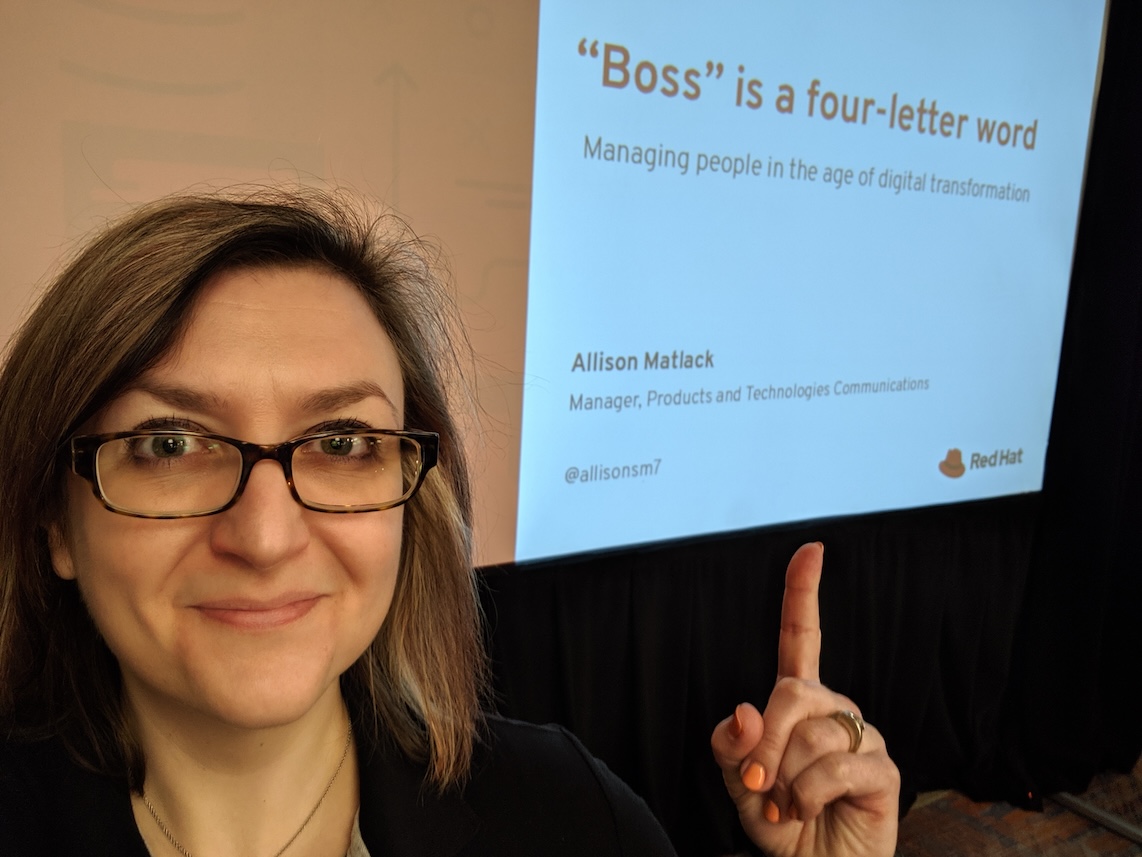When people ask me about my leadership style, or what expectations I have of my own managers, I like to tell a story about chairs.
I spent several years early in my career working as a copy editor in a small software engineering department responsible for our company’s customer web portal (which housed support ticketing, product lifecycle information, the knowledge base, etc.). At some point, we had a reorganization, and leadership was kind enough to give me a choice: I could go with my then-manager, who was splitting off to lead a stand-alone technical documentation team, or I could stay with the development team. Either way, my role would be changing in yet-to-be-determined ways.
After some conversations and a small existential crisis, I decided to stay with the developers, taking on a business analyst title (though I can’t say for certain I did any actual business analysis before I was promoted to project manager) on the team responsible for the support ticketing system.
That one decision, and two different chairs, changed the entire trajectory of my career and formed the foundation of my own approach to management.
Leveling up through partnership
I came into my new role full of questions – about expectations of me, about the systems we were working on, about the business context driving decisions – and my new manager, Mike, leaned in to my curiosity and taught me pretty much everything I know about project and stakeholder management, systems thinking, and business administration. He invested a significant amount of time in ensuring I had the context needed to do my best work. I still remember spending hours with him at whiteboards whenever he flew in to visit the team, and many of his lessons, like “stakeholders are capricious gods”, still live rent-free in my head.
Mike also encouraged me to explore and develop in areas that piqued my interest, assigning me work that allowed me to get experience in different disciplines and areas of the business. For example, at one point, we had two separate Scrum teams struggling to manage dependencies, so I did research about scaled Agile frameworks and proposed we give Large-Scale Scrum (LeSS) a try, and that ended up reducing time for cross-team feature deployment by 50%. Suddenly, I found myself giving talks at developer conferences.
Perhaps most importantly, Mike made it safe to be vulnerable, to take risks, and to fail. He consistently and vocally had my back in public, while offering advice and corrections and challenging me to be better in private. I used to take every business decision extremely personally; once, when I asked for promotion and he told me I wasn’t ready, I couldn’t stop myself from crying. He responded by talking me through both the specific reasons why he didn’t think I was ready (and what I would need to do to be ready), and why his response was in no way personal. I asked for his advice on how not to cry in future conversations like that, and I still follow his suggestion sometimes, to practice what I have to say while staring at myself in the mirror, until I don’t cry anymore.
Pulling up a chair
After about two years working with (and learning from) Mike, I had a revelation about what I really wanted to be doing with my career: Our department had grown significantly, and I realized I didn’t know the people in our department who sat down the hall from my cubicle, much less our teammates in India and China, and I wanted to fix that.
Mike told me that associate engagement was something on our leadership’s mind and that he and the leadership team were likely to be discussing it during an upcoming planning session. He told me I should come.
I showed up at the specified date, time, and location only to find the large conference room at capacity. I walked in and stood awkwardly in the corner, waving to everyone. Mike immediately hopped up and left the room to find a chair, which he wheeled right up to the table where everyone was sitting, making room between our director and another manager.
As Mike had promised, as the presentations resumed, they started talking about associate engagement and what suggestions folks had for improvement. I shot my arm straight up in the air and said, “I’d like to solve that problem.” And because I was in that room, at that table, at that moment, with Mike backing me up, I was granted approval to build out a new role for myself, designing an associate engagement program from the ground up.
So, what’s next?
As I built out my new role and tried to form partnerships across the company to assist, it became clear that my place in the organizational hierarchy was limiting: Some people would ask me who I reported to, and I could almost see them mentally going down through the different levels of the org chart before they dismissed me for being not worth their time.
Once we shifted the reporting structure so I reported to our director, that problem went away, and my role morphed into something more like a chief of staff. I had a lot of fun and did a lot of great work there, including building out a mentoring program that became the base of the company-wide program still in existence today.
I also gave several conference talks about the importance and impact of a strong partnership between a highly driven associate and an advocate manager, based on everything I’d learned from working with Mike, and I always included that story about him wheeling in a chair for me as the strongest example of advocacy and servant-leadership.
My director attended one of those talks, and it must have resonated, because he called me to talk about it a few weeks later, saying, “You have a really interesting career story. So, what’s next?”

Image: Me, giving one of those talks
My own chair
I didn’t understand it at the time – at the time, I felt like I was being fired – but kicking me out of the nest was the best thing my director ever could have done for me. What he was saying was that he had scaled me as much as he could, given the size and scope of his department, and he knew I was destined for more.

I went through a few rounds of interviews for different internal positions, and while none of those positions were really the right fit, it was hard not to take it personally when I was passed over. But after a few months of looking, the right position opened, and I stepped up to lead the internal communications team for our Products and Technologies division (which meant the audience I served went from about 150 to about 9,000).
It was bittersweet to leave my team, even though I wasn’t going far, because I had been with them for more than seven years. They organized a small going-away dinner – complete with gluten-free cake! – which I greatly appreciated, as I had always been the one doing the event planning.
And then my director brought out a box. Inside the box was a director’s chair with my name on it.
“Now you can pull your own chair up to any table,” he said.
Lessons for leadership
Those two chairs – the one Mike wheeled up to the table, and the director’s chair with my name on it – have become powerful symbols for me, representing not just physical seats, but the mindset and approach to bring to management.
As I took on my new role as manager, I found myself constantly drawing from the lessons I learned from Mike and my director. Their investment in my growth, their unwavering support, and their willingness to challenge me shaped my leadership style. I did my best to embody the principles they taught me for my team:
- Set the context: Ensure the team understands the bigger picture. Dive into the “why” behind the projects, and connect the dots between daily tasks and the organization’s overarching goals. Context is the compass that guides us through the complexities of our work.
- Invest time: Time spent upfront pays dividends later. Be available for questions, brainstorming sessions, and one-on-one conversations. It’s in those moments that trust is built, and understanding flourishes.
- Make it safe: Vulnerability isn’t weakness; it’s the foundation of growth. Encourage the team to take risks, knowing that failure is an opportunity to learn. Stand by them publicly and offer guidance privately.
- Take calculated risks: There’s no need to take blind leaps, but take risks on team members who show promise, whether that means leading a high-visibility project or presenting at a conference. And when they succeed, be their loudest cheerleader.
- Open doors: Introductions matter. Connect the team with influential colleagues, encourage them to participate in cross-functional initiatives, and delegate projects that boost their visibility. It’s about expanding their horizons and showing them that their contributions extend beyond the immediate team.
- Advocate: Champion the team’s talents. Sing their praises in meetings, fight for their professional development, and go out of the way to say good things in front of the people who matter. And because leadership is about nurturing talent, not hoarding it, encourage them to explore opportunities elsewhere if it’s in their best interest.
True leadership isn’t about titles or org charts; it’s about pulling up chairs for others, creating spaces where they can thrive, and watching them soar.
And if you ever visit my office, you’ll find that director’s chair tucked in the corner, as a reminder that leadership isn’t about having all the answers – it’s about empowering others to find them.
